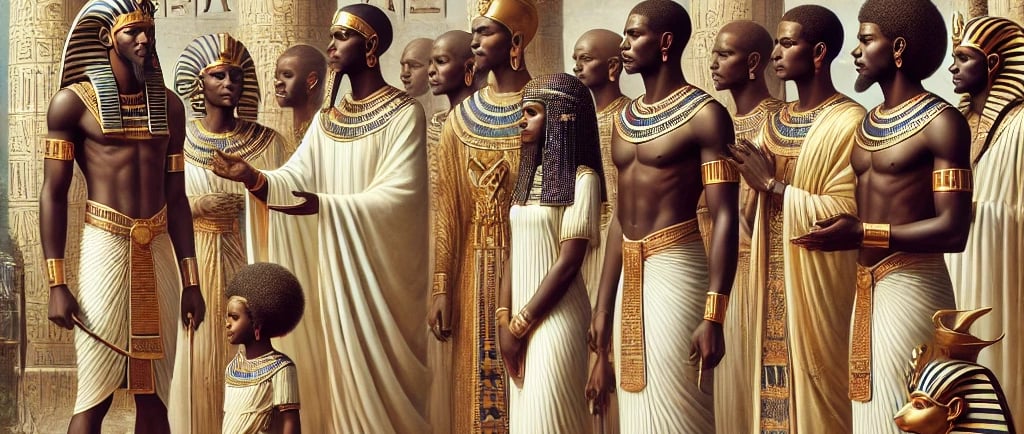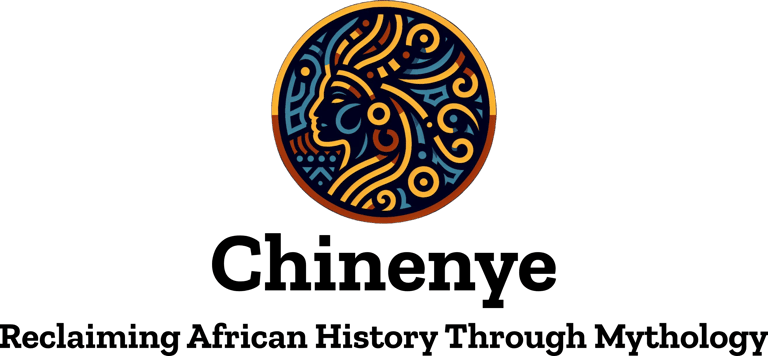The Black Republic of Kemet (Modern Day Egypt)
Egypt was once upon a time the Black Republic of Kemet, known to its people as 'Kmt'. Hidden Africa is the reason you do not know that Kemite was a Black Republic and the Pharaohs were the All Black Pharaohs of African Antiquity. Welcome to Hidden African and Black History.
AFRICAN HISTORY IS INCOMPLETE......OVERWRITTENTHE CODEX OF NILE TIME
Chinenye Egbuna Ikwuemesi
7/19/20256 min read


The Black Republic of Kemet
(The All Black Pharaohs of African Antiquity)
Mythology, Memory, and the Architecture of Order
By Chinenye Egbuna Ikwuemesi
African history is incomplete without its mythology.
This is the foundational truth behind this essay, the series to which it belongs, and indeed the wider body of mythological restorations I am undertaking. If the West cannot speak of Greece without reciting her pantheon, her myths of Olympus, her trials of heroes and gods, then why is African history taught and imagined with its myths erased, its deities unnamed, its sacred stories redacted?
This essay is part of my broader project to reframe African mythology as civilisational infrastructure, a system of public law, memory, cosmology, architecture, governance, ethics, and identity encoded not just in belief, but in built form, ritual protocol, celestial science, and civic design.
And nowhere is this more apparent than in Kemet, the so-called ancient Egypt, which I now name, unapologetically, the Black Republic of Kemet.
A Mythological Republic Disguised as an Empire
Kemet was not just a monarchy with monumental temples. Kemet was a republic of rituals, a public choreography of moral and cosmic order. The divine order of Ma’at was a living metric, a cosmic equilibrium that determined whether the Nile would flood correctly, whether justice would flow in the courts, and whether the soul of a citizen was balanced enough to join the ancestors.
The priest was a public official; the temple served as a school, a bank, a laboratory, and a court. Mythology in Kemet was a national operating system. Every institution in Kemet was mythologically coded. The House of Life (Per Ankh) was a scriptorium and the national archive, the mythic memory bank. The temple schools taught hymns alongside hieroglyphic logic, healing science, and the principles of cosmic justice. The Neteru, often miscast as “gods,” were functional archetypes used to design civic protocols: Hetheru for beauty and diplomacy, Djehuty for thought and record, Sekhmet for medicine and retribution, and so on.
Philosophy, systems, order and infinite beauty. Let the recognition resonate.
This was the Republic’s architecture: a society where myth informed ministry, where the divine pantheon was mapped onto real institutions of statecraft, and where to govern was to be cosmologically accountable.
Every citizen of Kemet lived inside myth. Not beside it. Not after it. Inside it.
The Republic of Kemet was not democratic by modern terms, but it was participatory by cosmological design. Its laws, rituals, festivals, and even funerary rites bound the citizen to the state and the state to the cosmos. This, like a majority of early and pre-colonial African societies, was a republic of balance, not ballots, and sovereignty flowed not only from the pharaoh but from the correct performance of Ma’at across all levels of life: agricultural, judicial, astronomical, and spiritual.
Citizenship in Kemet meant more than birthplace or bloodline. It meant alignment, participation in the sacred rhythm, knowledge of the Nile, and obedience to cosmic equilibrium. Kemet was a republic of initiates, not just subjects. Once again, we see that primary characteristic, where the power and success came from communal practices of what was important or sacred.
And it was Black. A republic full of Black people like you never hear about in the prevailing myth in the West which teaches that Africans could not effectively rule themselves and is the very reason why you may not have known that the most vaunted African civilisation was actually a fully Black one.
It was Black, this exceptional civilisation, not in modern pigment politics alone, but in civilisational authorship. Black people built their rituals, mapped their skies, farmed their soil, coded their myths, ruled their courts, and judged their dead. The Black Republic of Kemet was the first large-scale experiment in myth-based governance. And it worked.
The Weighing of the Heart and the Civic Imagination
At the heart of Kemetic moral logic lies one of the most misunderstood myths in African cosmology, 'the Weighing of the Heart'. This was precept was not concerned just with the afterlife but was an instruction in the public ethics of balance. Your heart, considered seat of memory, action, and intent, was to be weighed against a feather, the emblem of truth.
It was a standard and a promise: if your society could maintain Ma’at, and sustain and revere justice, balance, reciprocity, and truth, then your heart would not be weighted down with guilt and then your land would flourish, with your heart as light as a feather.
Imagine if every political leader today knew that their soul would be weighed not by God’s whim, but by the integrity of their decisions. Kemet encoded that into their national memory through myth.
The Journey of Ra and the Architecture of Time
We are accustomed to conceiving time in the West as a straight line - past, present, future; life then death - but the people of Kemet envisioned it as a cycle, a recurrence, and a rhythm of return and justice with the central sun god Ra, journeying through the Duat, the underworld, each night, and fighting chaos to be reborn at dawn.
This myth taught more than astronomy. It offered a cosmological justification for resilience, for regeneration, for the endless labour of light against darkness.
In Kemet, the responsibility to understand the movement of the sun was not to science alone but to spiritual duty. You were expected to rise, like Ra. You were expected to conquer your chaos, like Ra and be steadfast.
Osiris and the Politics of Reassembly
The dismemberment and resurrection of Osiris, king and god, is a metaphor for justice in times of catastrophe. His body is torn apart by betrayal, but his consort Isis reassembles him. Their son, Horus, goes on to restore the divine kingship. Do you know the prevailing themes in this parable about restoration, succession, grief, and reparation? The logic of statecraft rendered sacred. This is also the first recorded instance of resurrection as a political act, and that is why I recount it.
The Osiris cycle, in fact, is not only an African myth — it is arguably the parent script of several resurrection doctrines across global faiths and philosophies. How many of us know this?
From Nile Time to Mythic Governance
Kemet operated on a temporal logic tied to the flooding of the Nile, the rising of Sirius, and the agricultural cycle, all of which were intertwined with its mythology. The calendar wasn’t secular. It was sacred.
The Sothic cycle was a 1,460-year astronomical rhythm that guided the long memory of dynasties, where the sacred and the scientific were not at odds.
The Rationale for the Reclamation and Reframing of African History
This is why I argue that mythology in Kemet was not superstition; it was a knowledge system, an operating manual, and a civilizational logic. The clarity with which mythology and life mesh is a strong example of asserting a history as vast as Africa's, while obfuscating its mythologies is intellectually limited and dishonest.
We live in a world that continues to frame African people as ahistorical, as latecomers to knowledge, as consumers of civilisation rather than its authors. Kemet refutes that. Kemet was an exemplar, but it was not even an exception.
This is why I have begun restoring African history through the lens of its myriad and magnificent mythologies.
This and similar models were interrupted, overwritten, and then misremembered, so that our world still speaks of Plato, but not so much of Ptah, quotes Rome, but not Ra, and mimics Athens, but forgets Abydos. Most damningly of all, they never acknowledge the deep Africanness of Egypt. Black people weren’t just there. We were the architects. Of calendars. Of courts. Of climate cycles and cosmological codes. We were not waiting to be discovered; we were running things. Governing by gods we named, ruling by laws we wrote, harvesting by stars we tracked, healing with systems we built from bark and blood and breath.
This is why, when we say 'The Black Republic of Kemet,' we are naming a blueprint —a republic founded on spiritual law, a civic model where myth was infrastructural, and where the balance of the cosmos dictated the balance of the court.
As part of my codex series on African civilizational thought, this work is both historical and speculative, poetic and practical. It provides a new foundation for how we might teach, govern, and envision the future.
Kemet birthed the pyramids and powerful civilisational protocols: how to order time, weigh justice, process grief, govern a state, honour the dead, manage flood and famine. These weren’t primitive ideas. They were sophisticated civic memory systems — and they were ours.
When the West came with their chains, and the East with their crescent, they didn’t just steal our bodies. But they also stole the manuals: ripped the pages from our temples, renamed the deities, Arabized the Nile and colonised the memory. For a ribbon and bow, they called Africans late, lost and savage. They said Africa was lacking in civilisation! Restoring the Kemets gives the lie to all that - Africans had civilisation on lock right from the start.
And now? We’re getting it back, because if you didn't know, now you do. And you can share this with others: The Black Republic of Kemet reclaims Black African sovereignty, and restores the memory and knowledge of what we made.
This essay is part of an ongoing canon-building project by Chinenye Egbuna Ikwuemesi, mythologist, system-builder, and founder of the Afrodeities Institute.
This essay is based on a codex in progress, The Knowledge of Kemet (The All Black Pharaohs of African Antiquity), a foundational text in the African Mythology Series — restoring the narrative, logic, and authority of African myth as history, justice, and public architecture.
To collaborate, commission, or invite Chinenye to speak, visit Chinenye.co.uk.
Reframing African History by Reclaiming African Mythology
Restoring African mythology through innovative storytelling.
chinenye@chinenye.co.uk
© 2025. All rights reserved.
